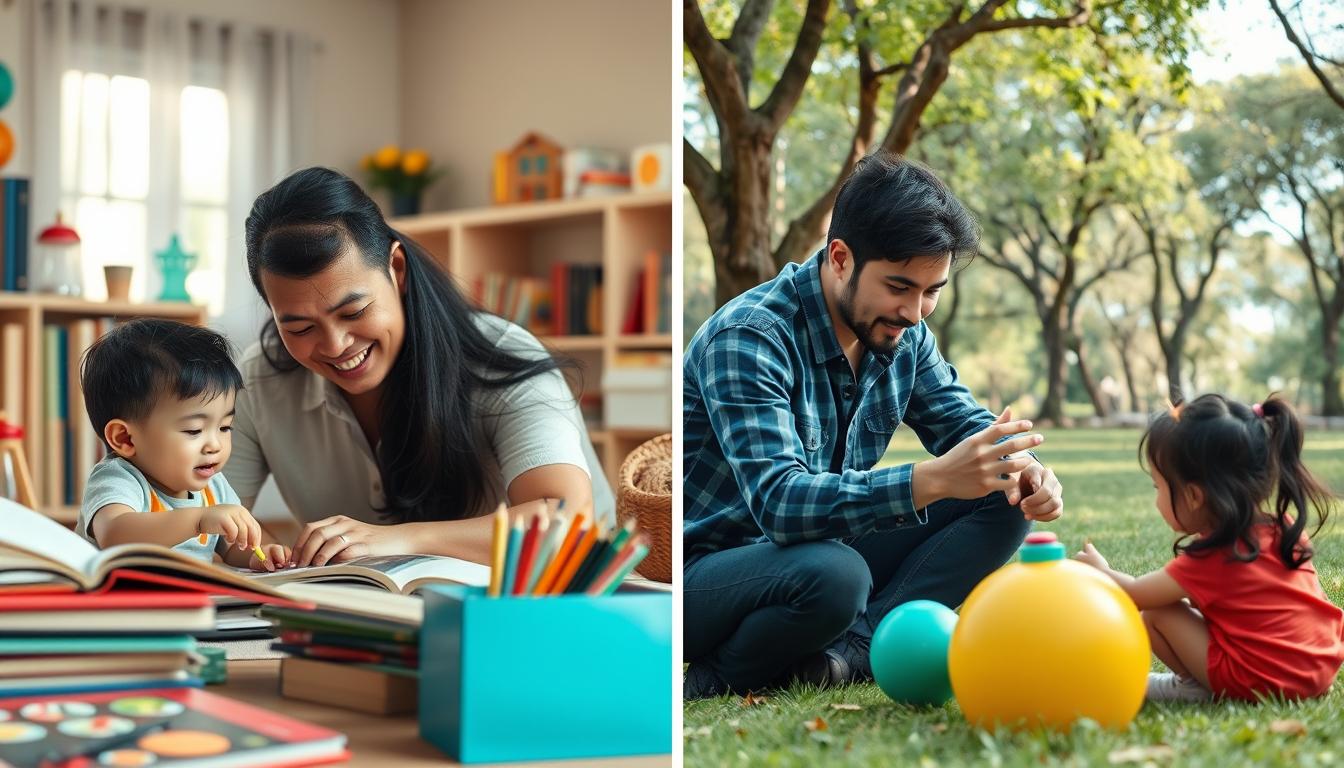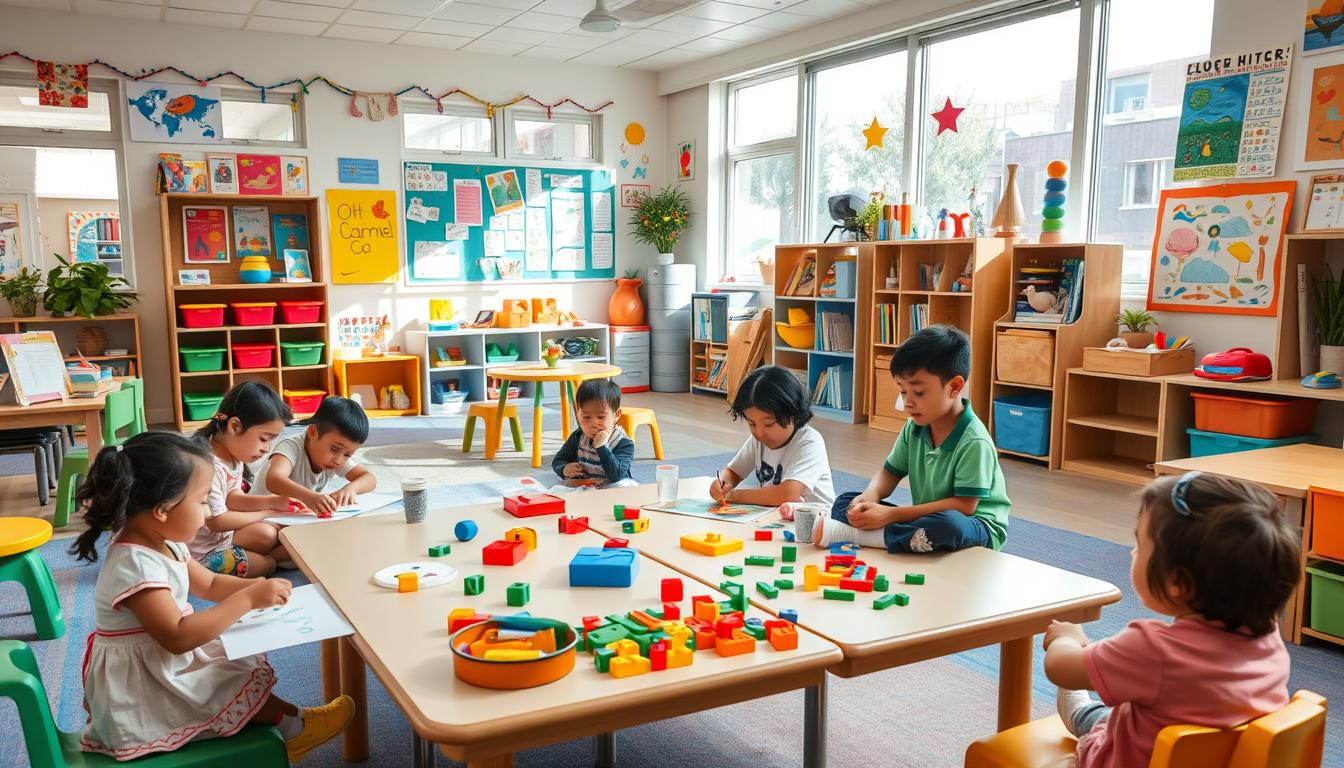
Childhood should be filled with laughter, adventure, and wonder. But, even young kids can feel a lot of stress. This stress can affect their emotional, physical, and mental health. In this guide, we’ll explore why kids get stressed, how to spot the signs, and share tips to help them manage stress.
We’ll look at how to understand stress in kids, find ways to calm them down, and build their resilience. By talking openly, teaching healthy ways to cope, and creating a supportive environment, we can help kids grow strong and confident. They’ll be better equipped to face life’s challenges.
Key Takeaways
- Recognise the common causes of stress in children, such as academic pressure, family changes, and social challenges.
- Identify the signs of stress in kids, including behavioural changes, physical symptoms, and emotional distress.
- Encourage open communication and create a safe space for children to express their thoughts and feelings.
- Implement relaxation techniques and mindfulness activities to help kids manage stress and anxiety.
- Foster resilience and healthy coping strategies to equip children with the tools to navigate life’s ups and downs.
Understanding Childhood Stress
Stress is a normal part of life for kids, just like for adults. But when it gets too much, it can really affect a child’s happiness and growth. Knowing what causes and shows stress in kids is key to helping them handle it.
What Causes Stress in Children?
Many things can make kids stressed, like school pressure, social issues, family problems, and big life changes. Kids face a lot, from school work and sports to friends and family changes. It’s important to help them manage stress for their mental health.
Signs of Stress in Kids
It’s vital to spot the signs of stress in kids. This includes physical, emotional, and behaviour changes. Look out for:
- Physical signs like headaches, tummy aches, or feeling tired
- Emotional signs like feeling anxious, moody, or easily upset
- Behavioural signs like trouble focusing, pulling away, or being too loud
By noticing these signs, we can help kids deal with stress and support their mental health.
How to deal with stress for children
Helping kids deal with stress is key for their happiness. As parents and caregivers, we guide them through tough times. Here are some ways to help stressed children:
Encouraging Open Communication
Make a safe space for kids to share their feelings. Listen well to what they say and show you care. This helps them understand and manage stress better.
Promoting Healthy Coping Strategies
Teach kids good ways to handle stress, like deep breathing and being mindful. Physical activities also help. These skills build their strength and teach them to control their feelings.
| Coping Strategy | Description |
|---|---|
| Deep Breathing | Slow, deep breaths that can help calm the mind and body |
| Mindfulness | Practices that encourage present-moment awareness and focus |
| Physical Activity | Exercise, sports, or active play that release pent-up energy |
By teaching kids these strategies, we help them deal with stress better. This builds important life skills for them.
Fostering a Supportive Environment
Keep a regular routine and set fair goals. Create a loving, stress-free home. This makes kids feel safe and less stressed.
Every child is different in how they handle stress. By being patient and understanding, we can help kids handle stress and cope with stress in a healthy way.
Encouraging Open Communication
Talking openly and without judgment is key for how to deal with stress for children and supporting children’s mental health. Make a safe space for kids to share their feelings and worries. This helps them deal with helping kids handle stress.
Listening well is important for supporting children’s mental health. When your child talks about their worries, it’s important to listen and understand. Don’t make their feelings seem less important. This builds trust and helps them feel more comfortable sharing.
- Actively listen to your child, making eye contact and giving them your undivided attention.
- Avoid interrupting and resist the urge to offer immediate solutions. Instead, focus on understanding their perspective.
- Ask open-ended questions that encourage your child to elaborate on their thoughts and feelings.
- Reflect back what you’ve heard to demonstrate your comprehension and show your child that you’re truly listening.
Creating a safe space where your child feels heard and understood is powerful. It helps with how to deal with stress for children and supporting children’s mental health. Open communication builds empathy and resilience in kids.
Promoting Healthy Coping Strategies
As parents and educators, we help kids deal with childhood stress. We teach them relaxation techniques and mindfulness activities. These can really help.
Relaxation Techniques for Kids
Teaching kids to relax can change their lives. Simple methods like deep breathing and progressive muscle relaxation calm them down. These practices also boost their well-being and resilience.
Mindfulness Activities for Children
Mindfulness helps kids stay present and aware. Activities like guided meditations and sensory exercises teach them to pause and observe. This way, they handle stress better.
| Relaxation Techniques | Mindfulness Activities |
|---|---|
| Deep Breathing Progressive Muscle Relaxation Guided Imagery | Guided Meditations Sensory Awareness Exercises Mindful Walking |
By using these strategies, kids can manage stress in a healthy way. This prepares them for life’s challenges, now and in the future.
Building Resilience in Young Kids
As parents and caregivers, we aim to help children grow strong, even when things get tough. Building resilience in young kids is key to their mental health and happiness.
Resilience means bouncing back from hard times and adapting to new situations. By helping kids become resilient, we help them face life’s challenges with confidence. Here are some ways to build resilience in young kids:
- Cultivate a Positive Self-Image: Encourage kids to celebrate their strengths and what makes them special. Give them lots of positive feedback to boost their self-confidence.
- Teach Problem-Solving Skills: Help kids learn to think critically and solve problems. Guide them to break down issues, find solutions, and learn from mistakes.
- Embrace a Growth Mindset: Teach kids that they can grow their abilities with hard work and dedication. Celebrate their efforts and progress, not just results.
- Foster Emotional Intelligence: Teach kids to understand and manage their feelings. Give them ways to express emotions, like through art, writing, or sports.
- Build a Support Network: Surround kids with caring family, friends, and adults who can offer support and encouragement when needed.
By building resilience in young kids and supporting children’s mental health, we prepare them for a lifetime of emotional strength. They’ll be able to overcome any obstacle that comes their way.
| Resilience Trait | Description | Strategies to Develop |
|---|---|---|
| Positive Self-Image | The ability to see oneself in a positive light and believe in one’s own worth and capabilities. | Provide regular praise and encouragement Highlight children’s unique strengths and talents Encourage self-expression and self-acceptance |
| Problem-Solving Skills | The capacity to analyze problems, generate solutions, and learn from mistakes. | Guide children through problem-solving processes Encourage critical thinking and creative problem-solving Celebrate successes and learn from failures |
| Growth Mindset | The belief that one’s abilities can be developed through dedication and hard work. | Emphasize effort and progress over outcomes Encourage children to embrace challenges and take risks Teach the value of learning from mistakes |
“Resilience is not about being strong all the time. It’s about being able to bounce back from the tough times and grow even stronger.”
Creating a Supportive Environment
Creating a nurturing and supportive environment is key for kids’ mental health. It helps them deal with stress. Having regular routines and structures gives them stability and predictability. This is very helpful during tough times.
Establishing Routines and Structure
Consistent daily routines make kids feel secure and in control. This includes set bedtimes, meal times, and schedules for homework and play. A structured environment with clear rules reduces anxiety and helps kids manage stress better.
- Implement a regular sleep schedule to ensure kids are getting enough rest.
- Designate specific times for meals, homework, and leisure activities.
- Encourage children to participate in household chores and tasks to foster a sense of responsibility.
- Limit screen time and exposure to stressful news or media, especially before bedtime.
By making a supportive and predictable environment, parents and caregivers help kids feel safe and secure. This helps them handle stress better. It also improves their mental health and well-being.
Managing Anxiety in Kids
Anxiety is common in many children. It can be tough for parents and caregivers to handle. Recognising signs and offering support can greatly improve a child’s well-being.
Understanding what causes anxiety is key. Things like school pressure, social issues, or family changes can make kids anxious. Knowing the reasons helps parents find the right ways to help.
Talking openly with kids is vital. Letting them share their feelings without fear helps them feel heard and trusted. Teaching them to breathe deeply or practice mindfulness can also help them deal with anxiety on their own.
| Anxiety Management Strategies for Kids | Benefits |
|---|---|
| Cognitive-Behavioural Therapy (CBT) | Helps children identify and challenge negative thought patterns, leading to more positive and adaptive behaviours. |
| Relaxation Techniques | Includes deep breathing, progressive muscle relaxation, and visualization exercises to promote calmness and reduce physical symptoms of anxiety. |
| Regular Exercise | Physical activity can help release pent-up energy, improve mood, and boost overall well-being, which can alleviate anxiety. |
Using a whole approach to tackle anxiety is best. This includes emotional, cognitive, and physical aspects. With the right support, kids can learn to handle stress and thrive.
Calming Activities for Stressed Children
Children face many challenges as they grow up. They can feel overwhelmed and stressed. Luckily, there are many calming activities that help kids manage stress and find peace.
These activities range from creative outlets to physical exercise. They offer relief for young minds and help them cope with stress.
Art and Creative Outlets
Being creative is a great way to manage stress. Encourage kids to try drawing, painting, or sculpting. These activities let them express their feelings in a positive way.
Creating something can be very calming. It helps kids focus on the moment and forget their worries.
Physical Exercise for Stress Relief
Exercise is a proven way to reduce stress in kids and adults. Activities like sports, dance, or walks help release energy and improve mood. Exercise boosts endorphins, which calm the mind and enhance well-being.
By adding these activities to their daily routine, kids can handle life’s challenges better. Whether through creativity or physical activity, these strategies empower kids to face life with confidence.
Supporting Children’s Mental Health
Looking after our children’s mental health is very important. As parents, caregivers, and community members, we must create a supportive environment. This helps young people deal with stress and feel emotionally well.
Teaching our kids to be resilient is key. By showing them how to cope with problems and express feelings, we help them face life’s challenges confidently.
It’s also vital to encourage open communication. Children need to feel safe sharing their thoughts and feelings. Regular talks and listening can greatly support their mental health.
Fostering a Supportive Environment
Creating a caring and structured space is crucial for helping kids manage stress. Consistent routines, clear rules, and a sense of safety are important for their emotional wellbeing.
It’s also important to think about how our mental health affects our kids. Taking care of ourselves and showing healthy ways to cope sets a good example. This inspires our children to do the same.
“The greatest gift we can give our children is the assurance that they are loved, respected, and supported, no matter what challenges they face.”
Supporting children’s mental health is a journey. Small, consistent actions can make a big difference. Together, we can build a supportive community that helps our young people thrive mentally and emotionally.
TO WATCH VIDEO CLICK HERE
Conclusion
This article has given a detailed guide on helping kids deal with stress. We’ve learned how to spot stress signs and what causes them. Now, we know how to support our young ones better.
By talking openly and teaching healthy ways to cope, we help our children grow strong. This article has given us the tools to create a safe space for them to thrive.
It’s vital to tackle stress in kids to help them grow well. By teaching them to handle stress, we boost their mental health. This helps them face challenges and succeed in life.
Every child is different, so we need to tailor our support to fit their needs. This way, we help them reach their full potential.
Supporting kids’ mental health is a long-term effort. But with the right help and resources, we can make a big difference. Let’s keep helping our young ones develop the skills to overcome obstacles and look forward to a bright future.
FAQ
What are some common causes of stress in children?
Children often face stress from school pressures, social issues, family dynamics, and big life events. They might feel overwhelmed by schoolwork, friends, and changes at home.
How can I recognise the signs of stress in my child?
Look out for physical signs like headaches or stomach aches, emotional signs like being irritable or anxious, and behavioural signs like trouble focusing or more tantrums. Pay attention to any changes in how they feel or act.
What are some effective coping strategies for stressed children?
Teach them relaxation techniques like deep breathing and muscle relaxation. Encourage mindfulness through meditation or sensory exercises. Also, create a supportive environment where they feel free to talk about their feelings.
Why is it important to have open communication with my child about their stress?
Talking openly lets children feel understood and validated. It helps you understand their stress and find ways to solve it together. This builds their emotional awareness and coping skills.
How can I help build resilience in my child?
Building resilience means helping them feel good about themselves, teaching them to solve problems, and encouraging a growth mindset. Support them, keep routines, and let them face challenges safely.
What are some calming activities that can help stressed children?
Art activities like drawing or painting can be calming. So can physical activities like yoga or playing outside. These activities help them express and manage their feelings in a healthy way.
How can I support my child’s mental health during stressful times?
Support their mental health by creating a caring environment, talking openly, and teaching coping skills. Recognise signs of anxiety or other mental health issues and get help if needed. This helps them deal with life’s challenges.
TO SEE MORE TOPICS CLICK HERE


